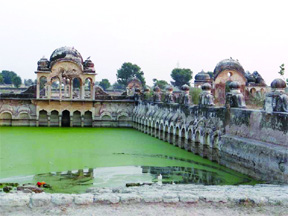
Shekhawati is a semi-arid getaway full of open air galleries, enchanting havelis & palaces and legendary forts. This region has been recognised as the open art gallery of Rajasthan”” having the largest concentration of frescos in the world.” Shekhawati has a history similar to that of Nawalgarh where in the Marwari men went to cities like Bombay and Calcutta in search of work and the time they found success and their businesses flourished, that is exactly when these plush havelis emanated. One businessman competed with the other in showing off his wealth, this continued on and on and finally, what the business families of Shekhawati got was an affluent city to live in. The inhabitants of Shekhawati are considered brave, sacrificing and hard working people. The region provides one of the highest number of people to the Indian Army. Hence, this location makes up for a dreamscape for all those wishing to get a blast from the past.
Sikar
Sikar is one of the most preferred excursions away from Shekhawati. It is host to plenty of prolific havelis and temples namely the Ram Chokhani Haveli, Bansidhar Rathi Haveli, Mirijamal Kyala Haveli, Kedia Haveli, Sanganeria Haveli, Radha Murli Manohar temple and the Jeen Mata temple are the relatively more famous ones. There is another popular temple in the village of Khatu Shyamji called the Khatu Shyamji temple which is renowned for its Jadula ceremony where a child’s hair are shaved off for the first time.
Churu
Churu is another jaunt a few km away from the town of Shekhawati located in the district of Shekhawati itself. Like many other towns in this area, Churu is also known for its Rajasthani architectural techniques clearly seen in its havelis and forts. One can see varied frescoes, paintings and carvings in the interiors of these havelis. The other major attractions are believed to be the chhatris like the Aath Kambh Chhatri and Gondia Chhatri.
Salasar Balaji
Salasar Balaji or Salasar Dham is a temple located in the small town of Salasar near Sujangarh in Churu district, Rajasthan. Dedicated to Balaji, another name for Hanuman, this temple attracts innumerable devotees throughout the year. Salasar Dham is in a religious circuit of centers of Khatu Shyamji temple and Rani Sati Dadiji (Jhunjhunu) temple and the Salasar Dham (or Balaji). All are located at a close proximity to each Other.
The magnificent temple was constructed in the year 1754 and is now considered as a shakti sthal (place of power), a place where all wishes come true. The idol of Lord Hanuman here is deemed to be swayambhu (self-created). It is believed that on Shravan Shukla-Navami in 1811 Samrat, a farmer in village Asia found a unique idol of Hanuman with beard and moustaches while ploughing the field. The idol was then sent to Salasar, and a temple was constructed in 1754 AD by Mohandas Maharaj.
On Chaitra Purnima and Ashvin Purnima, large fairs are organized and devotees from all over the country flock to the Dham to pay their homage to the deity. They parade to the temple barefooted, to prove the intensity of their devotion or to complete some mannat (wishes).
Nawalgarh
Nawalgarh is a miniature town situated at a short distance from Shekhawati. Fondly known as “the land of Havelis” or “open air art gallery”, this miniature town of Nawalgarh is located around 30 km away from the town of Jhunjhunu and does absolute justice to the name given to it.
It was named after Thakur Nawal Singh, who was the founder of the city. The Golden City of Rajasthan is the motherland of a lot of successful Marwari business families. It is said that the Marwaris who were off to cosmo cities like Bombay and Calcutta in search of work, used to send their hard earned money back to their homes in Nawalgarh. When their businesses started to flourish, they sent back artists to Nawalgarh in order to build plush palaces and show off their wealth. This lead to the rich architecture of this little town in Rajasthan.
Mandawa
Mandawa is a tiny township in the centre of the Shekhawati region, famous for trade and commerce. In the 18th century, the Rajput ruler of Mandawa and also the builder of the Roop Niwas Palace in Nawalgarh, built a lavish fort called here.
This attracted a lot of investors and traders from all across the country and they happened to settle here. Another major attraction in this township is the Castle Mandawa. Probably a tourist’s best bet for accommodation is this Castle which was turned into a heritage hotel a while ago. It might be a little too heavy on the pocket but this architectural wonder will make you understand that every penny of yours the moment you enter this posh hotel. A perfect amalgamation of ancient and modern architecture, this hotel has been restored keeping the old flavor in perfect condition whilst also adding the technology of today.





Be the first to comment